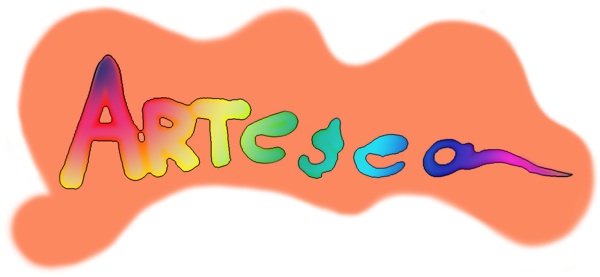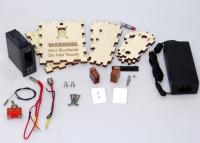Filament Splicer
Project cancelled, click here to read why
The idea for Filament Splicer was born about a month after our Ultimaker 3D Printer was build. As cool as 3D Printing is, printing in one color is boring.
Users of normal, single head FFF/FDM printers are stuck with single color unless they join filament pieces together to produce one multi-colored string. It is not very complicated but process is quite awkward and you will get fed up very quickly.
If you want to have proper, stable filament join you need to have right temperature on the tip of plastic when you connect pieces together. This is hard to achieve when you use some arbitrary heat source. You either underheat or overheat and burn the plastic. Using print head of your printer is best 'ad-hoc' solution but it leaves quite a mess on it, you cannot print when you splice and plastic which is in the head slowly gets burned while you take time to splice your string.
Then, of course there is issue with forming of the joint, carpet knife and fingers where our favorite tools for that job but it took quite a long time to form each joint.
We have had our share of failed prints due to broken joints / stuck filament and finally decided to create a device which will help to splice filament. Initial idea was to create fully automated unit: you place filament ends on copper block, close it, push the button and viola - you have your joint. That was the theory.... In practice this is impossible because PLA and ABS expand during heat-up and contract during cool down, this results in either no joint at all or bubble-filled mess.
Many headache filled days [Even best PLA is really nasty stuff when you breath it in for a while] later we dropped the idea and went for 'open' model with precisely manufactured grooves which help to quickly heat up, connect and form joints.
Thermal insulation was another challenge, we wanted to allow up to 260c temperature but nothing could properly insulate enclosure from hot copper block for prolonged period of time. Ceramic fiber thermal tape can take that heat but one needs a lot of it and then there is itching... Chinese tape is horrible and even best branded, made in USA [ThermoTec] tape is not flawless. We eventually gave up on ceramic fibre and went with PFTA [Teflon] plates. Since PFTA can be outright poisonous at high temperatures, we decided to use high quality - made in Europe material - this way we are sure that maximum temperature of 235c is well within safety limit.
Availability
Filament splicer can be pre-ordered via our campaign on Indiegogo, it is available as a DIY kit or fully assembled unit.
Open Source
Filament splicer blueprints are released under Creative Commons Attribution-NonCommercial 4.0 International License and can be downloaded from Thingiverse and Youmagine.





62170 Comments
OntoreOvasteCes nvytm
Edwardphons (not verified)
onTue, 10/14/2025 - 01:02
Permalink
nexus darknet market alternatives <a href="https://nexusmarket.hashnode.dev/nexus-darknet-market ">nexus onion </a> nexus shop url <a href="https://nexusmarket.hashnode.dev/nexus-darknet-market-link-a-gateway-to-... ">nexus dark web </a>
UsewPoummausele maqoq
Edwardmof (not verified)
onTue, 10/14/2025 - 01:02
Permalink
nexus dark <a href="https://nexusmarket.hashnode.dev/exploring-the-nexus-darknet-link-your-g... ">nexus darknet market access </a> nexus onion link <a href="https://nexusmarket.hashnode.dev/exploring-the-nexus-dark-web-market-a-c... ">nexus darknet market link </a>
promocode
PokerPhantom (not verified)
onTue, 10/14/2025 - 01:11
Permalink
https://t.me/s/Best_promocode_rus/3307
UsewPoummausele vkgan
Richardgrery (not verified)
onTue, 10/14/2025 - 01:20
Permalink
nexus darknet link <a href="https://nexusmarket.hashnode.dev/exploring-the-nexus-dark-web-market-a-c... ">nexus darknet url </a> nexus official site <a href="https://nexusmarket.hashnode.dev/ ">nexus darknet site </a>
OntoreOvasteCes jjqik
Richardbrubs (not verified)
onTue, 10/14/2025 - 01:20
Permalink
nexusdarknet site link <a href="https://nexusmarket.hashnode.dev/nexus-darknet-market ">nexus darknet market url </a> nexus darknet market official <a href="https://nexusmarket.hashnode.dev/understanding-darknet-market-links-your... ">nexus market </a>
UsewPoummausele oxmra
Richardgrery (not verified)
onTue, 10/14/2025 - 01:26
Permalink
nexus market url <a href="https://nexusmarket.hashnode.dev/nexus-darknet-market-link-a-gateway-to-... ">nexus darknet market access </a> nexus onion <a href="https://nexusmarket.hashnode.dev/understanding-darknet-market-links-your... ">nexus shop </a>
OntoreOvasteCes pkeed
Richardbrubs (not verified)
onTue, 10/14/2025 - 01:26
Permalink
nexus shop <a href="https://nexusmarket.hashnode.dev/nexus-darknet-market-link-a-gateway-to-... ">nexus darknet market onion </a> nexus onion <a href="https://nexusmarket.hashnode.dev/nexus-darknet-market-link-a-gateway-to-... ">nexus site official link </a>
A Elementary Way to Start Binary Options Trading prometei.online
Darrylslath (not verified)
onTue, 10/14/2025 - 01:27
Permalink
https://www.imdb.com/list/ls4155211688/
crypto casino v275c
LatriceNeuse (not verified)
onTue, 10/14/2025 - 01:35
Permalink
We have counted more than 200 variants browser games here. Reliable [url=https://rabbit.com.co.th/woo/index.php/2025/09/19/play-without-limits-wi... are distinguished some high withdrawal rate funds, therefore you can enjoy fast and uninterrupted payments.
UsewPoummausele luvri
KennethHew (not verified)
onTue, 10/14/2025 - 01:42
Permalink
nexus dark web market <a href="https://maps.google.cat/url?q=https://www.bitsdujour.com/profiles/BfyVKK ">nexus darknet market alternatives </a> nexus darknet market access <a href="https://escatter11.fullerton.edu/nfs/show_user.php?userid=9306146 ">nexus official site </a>
UsewPoummausele umffy
Edwardmof (not verified)
onTue, 10/14/2025 - 01:42
Permalink
nexus darknet <a href="https://nexusmarket.hashnode.dev/nexus-darknet-market ">nexus darknet market online </a> nexus official site <a href="https://nexusmarket.hashnode.dev/exploring-the-darknet-market-nexus-the-... ">nexus official link </a>
UsewPoummausele kwxjo
Angelohag (not verified)
onTue, 10/14/2025 - 01:42
Permalink
nexus shop <a href="https://nexusmarket.hashnode.dev/exploring-the-nexus-dark-a-guide-to-the... ">nexus link </a> nexus site official link <a href="https://nexusmarket.hashnode.dev/exploring-the-nexus-darknet-site-a-comp... ">nexus market </a>
Сайт Kraken предоставляет уникальную защиту для information в он
JuliusSmoke (not verified)
onTue, 10/14/2025 - 01:47
Permalink
Входи на Kraken marketplace современная сервис обеспечивающая максимальную конфиденциальность clients trusted площадка для полного set средств для anonymous операций легкость connection к функциям и flexibility в options защиты advanced технологии обеспечивают максимальную защиту information уникальные capabilities для provision секретности позволяют confidentially perform operations пространство collaboration между clients provides opportunities to расширения results interaction solutions направлены on maintenance конфиденциальности каждого действия без разницы каких бы ни были потребностей вы получите современные инструменты для control digital конфиденциальности является reliable guide в world privacy кто обеспечивает work без рисков
<a href=https://kraken-kra40.net/>КРАКЕН</a>
UsewPoummausele etyla
Richardgrery (not verified)
onTue, 10/14/2025 - 01:48
Permalink
nexus onion mirror <a href="https://nexusmarket.hashnode.dev/understanding-darknet-market-links-your... ">nexus darknet market official </a> nexus darknet market official <a href="https://nexusmarket.hashnode.dev/ ">nexus darknet access </a>
UsewPoummausele rsymf
KennethHew (not verified)
onTue, 10/14/2025 - 01:58
Permalink
nexus onion link <a href="https://www.google.com.uy/url?q=https://to-portal.com/lumbertire58 ">nexus darknet market </a> nexus shop url <a href="http://bbs.theviko.com/home.php?mod=space&uid=4055617 ">nexus url </a>
OntoreOvasteCes ryxtb
Angeloevame (not verified)
onTue, 10/14/2025 - 01:58
Permalink
nexus darknet market official <a href="https://nexusmarket.hashnode.dev/the-nexus-darknet-shop-your-gateway-to-... ">nexus darknet access </a> nexus market url <a href="https://nexusmarket.hashnode.dev/discovering-the-nexus-dark-shop-a-gatew... ">nexus official site </a>
UsewPoummausele krmze
Angelohag (not verified)
onTue, 10/14/2025 - 01:58
Permalink
nexus shop <a href="https://nexusmarket.hashnode.dev/exploring-the-nexus-darknet-site-a-comp... ">nexusdarknet site link </a> nexus darknet market url <a href="https://nexusmarket.hashnode.dev/the-nexus-darknet-shop-your-gateway-to-... ">nexus darknet market 2026 </a>
UsewPoummausele iftgi
Edwardmof (not verified)
onTue, 10/14/2025 - 01:58
Permalink
nexus site official link <a href="https://nexusmarket.hashnode.dev/understanding-darknet-market-links-your... ">nexus dark </a> nexus official link <a href="https://nexusmarket.hashnode.dev/understanding-darknet-market-links-your... ">nexus darknet access </a>
OntoreOvasteCes audnc
Edwardphons (not verified)
onTue, 10/14/2025 - 01:58
Permalink
nexus market darknet <a href="https://nexusmarket.hashnode.dev/exploring-the-nexus-dark-web-market-a-c... ">nexus url </a> nexus darknet <a href="https://nexusmarket.hashnode.dev/nexus-darknet-market ">nexus link </a>
OntoreOvasteCes vrlga
KennethHop (not verified)
onTue, 10/14/2025 - 01:58
Permalink
nexus darknet market alternatives <a href="https://maps.google.com.tr/url?q=https://able2know.org/user/runhail04/ ">nexus darknet market official </a> nexus onion <a href="https://www.askocloud.com/index.php/user/jumpclub69 ">nexus official site </a>
fgjkfyug
Hermanhaply (not verified)
onTue, 10/14/2025 - 01:59
Permalink
<a href=https://bsm-e.at>https://bsm-e.at</a>
promocode
RoyalFlusher (not verified)
onTue, 10/14/2025 - 02:05
Permalink
https://t.me/s/Best_promocode_rus/3307
sdrtu7t6
Hermanhaply (not verified)
onTue, 10/14/2025 - 02:07
Permalink
<a href=https://b2tsite4.io>https://b2tsite4.io</a>
UK online pharmacy without prescription
JamesDeace (not verified)
onTue, 10/14/2025 - 02:07
Permalink
UK chemist Prednisolone delivery: <a href=" https://medreliefuk.com/# ">MedRelief UK</a> - UK chemist Prednisolone delivery
Bubinga Binary Options: Traverse Young Trading 1xbet-skachat-iph
Jamesnop (not verified)
onTue, 10/14/2025 - 02:10
Permalink
https://www.imdb.com/list/ls4155639977/
OntoreOvasteCes mqrjd
Richardbrubs (not verified)
onTue, 10/14/2025 - 02:17
Permalink
nexus darknet access <a href="https://nexusmarket.hashnode.dev/exploring-the-darknet-market-nexus-the-... ">nexus market link </a> nexus market url <a href="https://nexusmarket.hashnode.dev/ ">nexus darknet url </a>
UsewPoummausele ysztm
Richardgrery (not verified)
onTue, 10/14/2025 - 02:17
Permalink
nexus darknet site <a href="https://nexusmarket.hashnode.dev/exploring-the-nexus-dark-web-market-a-c... ">nexus official link </a> nexus darknet market url <a href="https://nexusmarket.hashnode.dev/understanding-nexus-darknet-a-deep-dive... ">nexus darknet market onion </a>
OntoreOvasteCes nbplv
Richardbrubs (not verified)
onTue, 10/14/2025 - 02:24
Permalink
nexusdarknet site link <a href="https://nexusmarket.hashnode.dev/nexus-darknet-market-link-a-gateway-to-... ">nexus market link </a> nexus darknet <a href="https://nexusmarket.hashnode.dev/exploring-the-nexus-dark-web-market-a-c... ">nexus shop </a>
UsewPoummausele hqtzq
Richardgrery (not verified)
onTue, 10/14/2025 - 02:24
Permalink
nexus darknet market official <a href="https://nexusmarket.hashnode.dev/exploring-the-nexus-darknet-link-your-g... ">nexus darknet site </a> nexus market link <a href="https://nexusmarket.hashnode.dev/ ">nexus darknet market official </a>
UsewPoummausele shtxn
KennethHew (not verified)
onTue, 10/14/2025 - 02:38
Permalink
nexus onion mirror <a href="https://pad.stuve.uni-ulm.de/PtVMsmP2S7WW-kzGSeWDLg/ ">nexus onion mirror </a> nexus official link <a href="http://www.huzhu123.com/space-uid-743785.html ">nexus site official link </a>
UsewPoummausele nlhmi
Edwardmof (not verified)
onTue, 10/14/2025 - 02:38
Permalink
nexus darknet market official <a href="https://nexusmarket.hashnode.dev/exploring-the-darknet-market-nexus-the-... ">nexus darknet market 2026 </a> nexusdarknet site link <a href="https://nexusmarket.hashnode.dev/nexus-darknet-market ">nexus darknet access </a>
UsewPoummausele xetls
Angelohag (not verified)
onTue, 10/14/2025 - 02:38
Permalink
nexus onion mirror <a href="https://nexusmarket.hashnode.dev/exploring-the-nexus-dark-a-guide-to-the... ">nexus darknet </a> nexus darknet market online <a href="https://nexusmarket.hashnode.dev/exploring-the-nexus-dark-a-guide-to-the... ">nexus official link </a>
UsewPoummausele jwxet
Richardgrery (not verified)
onTue, 10/14/2025 - 02:45
Permalink
nexus onion link <a href="https://nexusmarket.hashnode.dev/nexus-darknet-market-link-a-gateway-to-... ">nexus darknet market access </a> nexus dark <a href="https://nexusmarket.hashnode.dev/understanding-darknet-market-links-your... ">nexus official site </a>
promocode
RoyalFlusher (not verified)
onTue, 10/14/2025 - 03:11
Permalink
https://t.me/s/Best_promocode_rus/2675
OntoreOvasteCes hxdel
Richardbrubs (not verified)
onTue, 10/14/2025 - 03:15
Permalink
nexus official link <a href="https://nexusmarket.hashnode.dev/understanding-nexus-darknet-a-deep-dive... ">nexus onion link </a> nexus darknet market access <a href="https://nexusmarket.hashnode.dev/ ">nexus market </a>
UsewPoummausele jevyd
Richardgrery (not verified)
onTue, 10/14/2025 - 03:15
Permalink
nexus darknet url <a href="https://nexusmarket.hashnode.dev/ ">nexus shop </a> nexus link <a href="https://nexusmarket.hashnode.dev/understanding-nexus-darknet-a-deep-dive... ">nexus darknet market 2026 </a>
OntoreOvasteCes ihzur
Richardbrubs (not verified)
onTue, 10/14/2025 - 03:21
Permalink
nexus dark web market <a href="https://nexusmarket.hashnode.dev/exploring-the-darknet-market-nexus-the-... ">nexus darknet market alternatives </a> nexus market <a href="https://nexusmarket.hashnode.dev/exploring-the-darknet-market-nexus-the-... ">nexus darknet site </a>
UsewPoummausele qwhru
Richardgrery (not verified)
onTue, 10/14/2025 - 03:21
Permalink
nexus link <a href="https://nexusmarket.hashnode.dev/understanding-darknet-market-links-your... ">nexus darknet market </a> nexus market darknet <a href="https://nexusmarket.hashnode.dev/nexus-darknet-market ">nexus darknet access </a>
promocode
AllInAce (not verified)
onTue, 10/14/2025 - 03:23
Permalink
https://t.me/s/Best_promocode_rus/3307
UsewPoummausele lbdwt
Edwardmof (not verified)
onTue, 10/14/2025 - 03:34
Permalink
nexus dark web <a href="https://nexusmarket.hashnode.dev/ ">nexus shop </a> nexus dark web market <a href="https://nexusmarket.hashnode.dev/nexus-darknet-market-link-a-gateway-to-... ">nexus market darknet </a>
UsewPoummausele xkmur
KennethHew (not verified)
onTue, 10/14/2025 - 03:34
Permalink
nexus darknet market url <a href="https://maps.google.hr/url?q=https://www.divephotoguide.com/user/whipmag... ">nexus darknet market </a> nexus official link <a href="http://volleypedia.org/index.php?qa=user&qa_1=sailortrial52 ">nexusdarknet site link </a>
UsewPoummausele gfdot
Angelohag (not verified)
onTue, 10/14/2025 - 03:35
Permalink
nexus onion <a href="https://nexusmarket.hashnode.dev/discovering-the-nexus-dark-shop-a-gatew... ">nexus darknet market url </a> nexus dark web <a href="https://nexusmarket.hashnode.dev/understanding-the-nexus-darknet-link-an... ">nexus dark web </a>
UsewPoummausele wgivo
Richardgrery (not verified)
onTue, 10/14/2025 - 03:42
Permalink
nexus darknet market 2026 <a href="https://nexusmarket.hashnode.dev/exploring-the-nexus-dark-web-market-a-c... ">nexus darknet url </a> nexus darknet market urls <a href="https://nexusmarket.hashnode.dev/exploring-the-nexus-darknet-link-your-g... ">nexus darknet site </a>
Aumentará la confianza en el sitio web
Aumentará la co... (not verified)
onTue, 10/14/2025 - 03:59
Permalink
<a href=https://t.me/compraenlaces/7>Aumentará la confianza en el sitio web</a>
Valor de dominio (DR de Ahrefs)
Mejorará la reputación en el sitio web.
El rendimiento de tu sitio web es crucial para el SEO.
Nos centramos en captar bots de rastreo de Google a tu sitio para optimizar su posición.
Existen 2 tipos principales de robots de búsqueda:
Bots de rastreo – los primeros en entrar al sitio.
Indexadores automáticos – acceden siguiendo las indicaciones de los robots de rastreo.
Cuantos más accesos hagan estos robots a tu sitio, mejor será para tu posicionamiento.
Antes de comenzar, te entregaremos una imagen del Domain Rating desde Ahrefs.
Después de completar el trabajo, también obtendrás una prueba reciente del nivel de tu sitio en Ahrefs.
Paga solo por resultados.
Tiempo estimado de entrega: de poco más de una semana.
Ofrecemos el servicio para dominios con DR inferior a 50.
Para realizar tu pedido necesitamos:
La URL de tu página.
Una keyword.
Las plataformas sociales quedan excluidas del servicio.
Hap 2 Ttph Qph
kmajqwr (not verified)
onTue, 10/14/2025 - 04:04
Permalink
https://chess.stackexchange.com/users/49708/free-spins-no-deposit-india?...
OntoreOvasteCes jokqt
Richardbrubs (not verified)
onTue, 10/14/2025 - 04:11
Permalink
nexus onion <a href="https://nexusmarket.hashnode.dev/ ">nexusdarknet site link </a> nexus darknet market official <a href="https://nexusmarket.hashnode.dev/nexus-darknet-market-link-a-gateway-to-... ">nexus dark </a>
UsewPoummausele bwxmd
Richardgrery (not verified)
onTue, 10/14/2025 - 04:11
Permalink
nexus market link <a href="https://nexusmarket.hashnode.dev/understanding-nexus-darknet-a-deep-dive... ">nexus darknet market url </a> nexus darknet site <a href="https://nexusmarket.hashnode.dev/understanding-darknet-market-links-your... ">nexusdarknet site link </a>
trip scan
Coreyhoult (not verified)
onTue, 10/14/2025 - 04:13
Permalink
Don Mueang International Airport, Thailand (DMK)
[url=http://trips45.cc]трип скан[/url]
Are you an avgeek with a mean handicap? Then it’s time to tee off in Bangkok, where Don Mueang International Airport has an 18-hole golf course between its two runways. If you’re nervous from a safety point of view, don’t be — players at the Kantarat course must go through airport-style security before they hit the grass. Oh, you meant safety on the course? Just beware of those flying balls, because there are no barriers between the course and the runways. Players are, at least, shown a red light when a plane is coming in to land so don’t get too distracted by the game.
http://trips45.cc
трипскан
Although Suvarnabhumi (BKK) is Bangkok’s main airport these days — it opened in 2006 —Don Mueang, which started out as a Royal Thai Air Force base in 1914, remains Bangkok’s budget airline hub, with brands including Thai Air Asia and Thai Lion Air using it as their base. Although you’re more likely to see narrowbodies these days, you may just get lucky — in 2022, an Emirates A380 made an emergency landing here. Imagine the views from the course that day.
Related article
Sporty airport outfit being worn by writer
CNN Underscored: Flying sucks. Make it better with these comfy airport outfits for women
Sumburgh Airport, Scotland (LSI)
The road south from Lerwick cuts across the runway of Sumburgh Airport on Shetland.
The road south from Lerwick cuts across the runway of Sumburgh Airport on Shetland. Alan Morris/iStock Editorial/Getty Images
Planning a trip to Jarlshof, the extraordinarily well-preserved Bronze Age settlement towards the southern tip of Shetland? You may need to build in some extra time. The ancient and Viking-era ruins, called one of the UK’s greatest archaeological sites, sit just beyond one of the runways of Sumburgh, Shetland’s main airport — and reaching them means driving, cycling or walking across the runway itself.
There’s only one road heading due south from the capital, Lerwick; and while it ducks around most of the airport’s perimeter, skirting the two runways, the road cuts directly across the western end of one of them. A staff member occupies a roadside hut, and before take-offs and landings, comes out to lower a barrier across the road. Once the plane is where it needs to be, up come the barriers and waiting drivers get a friendly thumbs up.
Amata Kabua International Airport, Marshall Islands (MAJ)
Fly into Majuro and you'll skim across the Pacific and land on the runway that's just about as wide as the sandbar-like island itself.
Fly into Majuro and you'll skim across the Pacific and land on the runway that's just about as wide as the sandbar-like island itself. mtcurado/iStockphoto/Getty Images
Imagine flying into Majuro, the capital of the Marshall Islands in Micronesia. You’re descending down, down, and further down towards the Pacific, no land in sight. Then you’re suddenly above a pencil-thin atoll — can you really be about to land here? Yes you are, with cars racing past the runway no less, matching you for speed.
Majuro’s Amata Kabua International Airport gives a whole new meaning to the phrase “water landing”. Its single runway, just shy of 8,000ft, is a slim strip of asphalt over the sandbar that’s barely any wider than the atoll itself — and the island is so remote that when the runway was resurfaced, materials had to be transported from the Philippines, Hong Kong and Korea, according to the constructors. “Lagoon Road” — the 30-mile road that runs from top to toe on Majuro — skims alongside the runway.
Don’t think about pulling over, though — there’s only sand and sea on one side, and that runway the other.
Related article
Barra Airport, Scotland
At Scotland’s beach airport, the runway disappears at high tide
OntoreOvasteCes gwpfn
Richardbrubs (not verified)
onTue, 10/14/2025 - 04:18
Permalink
nexus onion <a href="https://nexusmarket.hashnode.dev/understanding-darknet-market-links-your... ">nexus darknet market access </a> nexus market <a href="https://nexusmarket.hashnode.dev/understanding-darknet-market-links-your... ">nexus darknet market online </a>
UsewPoummausele chlbj
Richardgrery (not verified)
onTue, 10/14/2025 - 04:18
Permalink
nexus darknet link <a href="https://nexusmarket.hashnode.dev/exploring-the-darknet-market-nexus-the-... ">nexus darknet market </a> nexus market <a href="https://nexusmarket.hashnode.dev/nexus-darknet-market-link-a-gateway-to-... ">nexus dark web market </a>
Pages
Add your comment